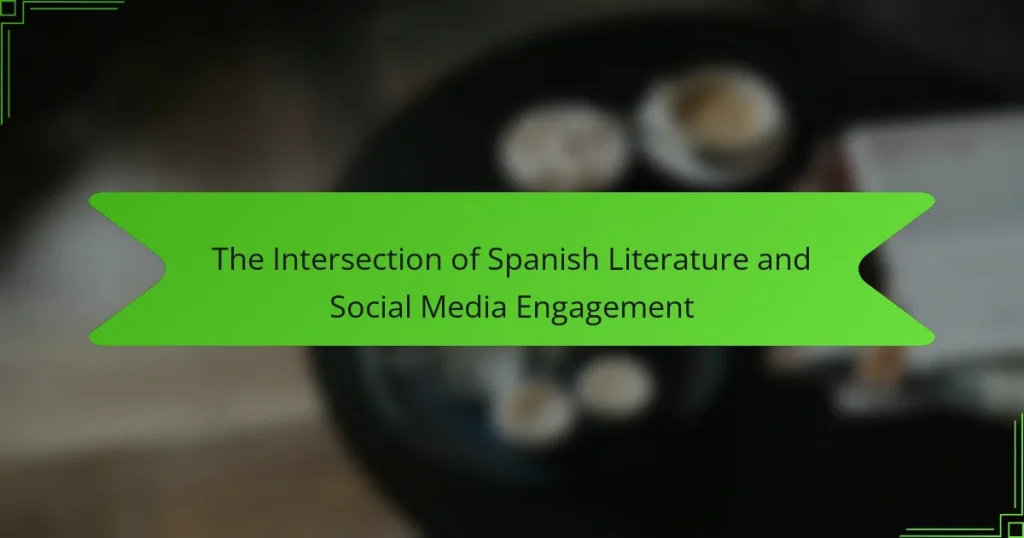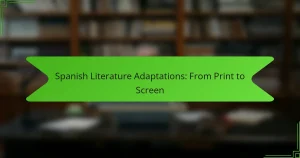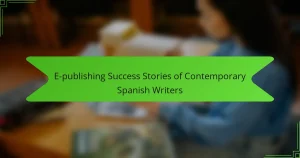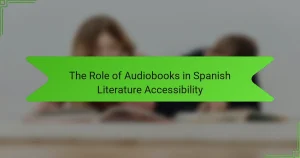Spanish literature increasingly engages audiences through social media, enhancing visibility and fostering community. Key themes like identity, social justice, and cultural heritage resonate with diverse readers. Authors face challenges such as limited visibility and language barriers while navigating these platforms. The dynamic interaction on social media shapes literary styles and democratizes access, allowing emerging voices to gain recognition.
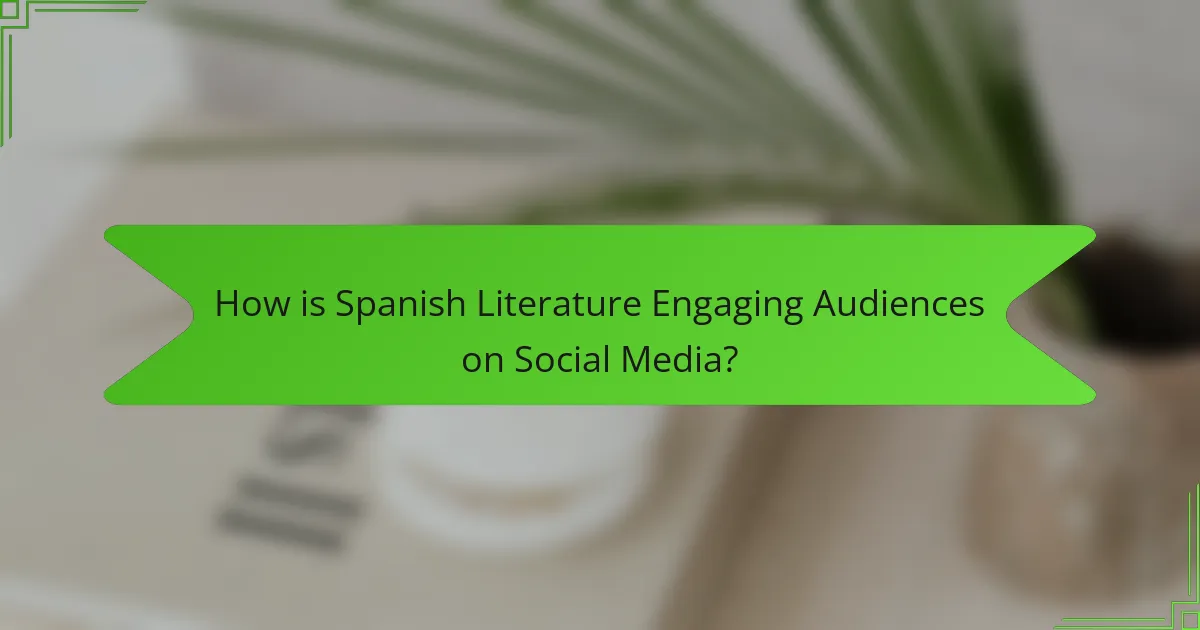
How is Spanish Literature Engaging Audiences on Social Media?
Spanish literature engages audiences on social media through relatable themes and interactive content. Authors leverage platforms like Twitter and Instagram to share quotes, host discussions, and promote literary events. This approach fosters community and encourages reader participation. Unique attributes of Spanish literature, such as its rich cultural history, resonate well with diverse audiences. As a result, engagement metrics show increased shares and comments, enhancing visibility and reach.
What Platforms Are Most Popular for Spanish Literary Engagement?
The most popular platforms for Spanish literary engagement include Instagram, Facebook, Twitter, and TikTok. These platforms facilitate vibrant discussions, book recommendations, and author interactions. Instagram excels in visual storytelling, while TikTok’s short videos attract younger audiences. Facebook remains strong for community-building among readers. Twitter serves as a space for real-time literary conversations and news.
How Do Authors Utilize Social Media for Promotion?
Authors leverage social media to enhance their visibility and engage with readers. They utilize platforms like Twitter, Instagram, and Facebook to share insights, promote new releases, and connect with literary communities.
Social media allows authors to build a personal brand, showcasing their writing process and daily life. For instance, Spanish authors often share excerpts or discuss themes relevant to their cultural heritage, creating a unique connection with audiences.
Engagement metrics reveal that posts featuring personal stories or interactive content receive higher engagement rates, fostering a sense of community. By using hashtags related to Spanish literature, authors can reach niche audiences effectively.
Overall, social media serves as a powerful tool for authors, enabling them to navigate the literary landscape and expand their readership.
What Role Do Literary Influencers Play in This Landscape?
Literary influencers play a crucial role in shaping the landscape of Spanish literature on social media. They amplify voices, promote new authors, and foster discussions around literary themes. By leveraging platforms like Instagram and Twitter, these influencers create communities that engage readers and writers alike. Their ability to reach diverse audiences enhances the visibility of Spanish literature, making it more accessible and relevant in today’s digital age.
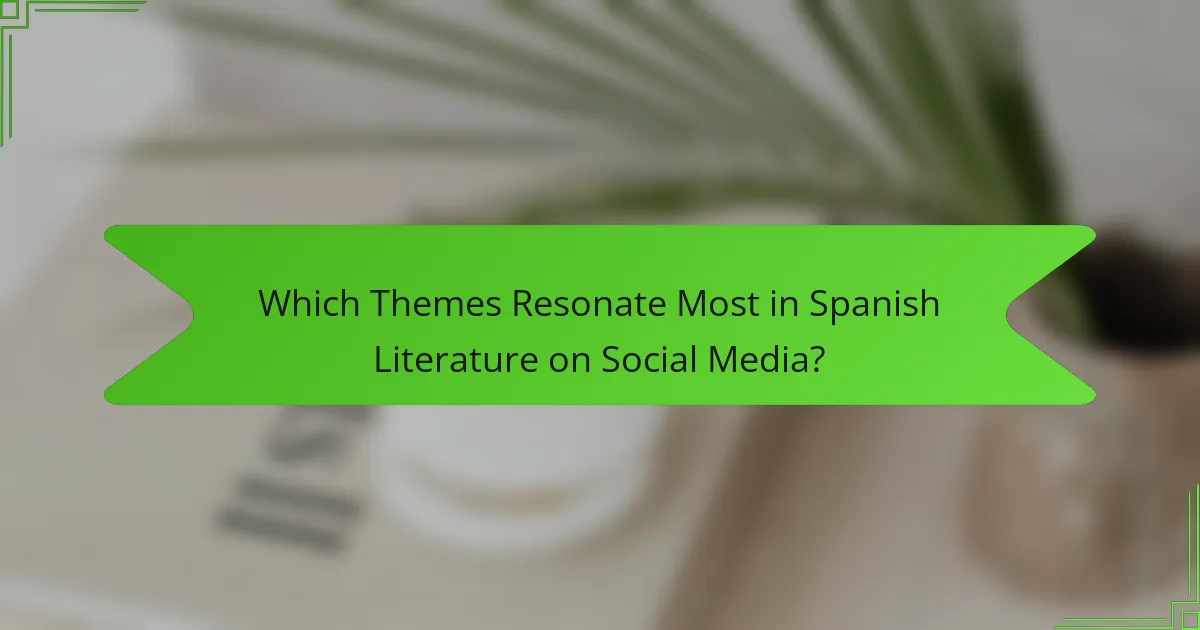
Which Themes Resonate Most in Spanish Literature on Social Media?
Themes that resonate in Spanish literature on social media include identity, social justice, and cultural heritage. These themes engage audiences by reflecting contemporary issues and personal experiences.
Identity exploration often highlights individual and collective narratives, fostering connections among readers. Social justice themes resonate due to the ongoing discussions around inequality and activism, prompting dialogue and engagement. Cultural heritage themes celebrate traditions and histories, appealing to a sense of belonging and pride.
The unique attribute of Spanish literature is its rich diversity, encompassing various regional voices and styles. This variety enhances social media engagement, as different demographics find representation in the narratives shared online.
How Do Cultural Contexts Shape Literary Themes in Different Regions?
Cultural contexts significantly shape literary themes in Spanish literature and its engagement on social media. Regional influences, such as historical events and societal norms, dictate the narratives and styles authors adopt. Social media amplifies these themes, allowing diverse voices to emerge and engage with traditional literature.
For example, contemporary Spanish authors often address issues like identity and migration, reflecting societal changes. The immediacy of social media fosters real-time discussions, enhancing the relevance of literary works. This dynamic interaction creates a unique platform for literature, where cultural contexts are not only explored but also actively shaped by audience engagement.
Moreover, social media enables cross-cultural exchanges, allowing Spanish literature to resonate globally. Authors can reach wider audiences, adapting their themes to reflect diverse perspectives. This evolution illustrates how cultural contexts and social media intertwine to redefine literary landscapes in Spain and beyond.
In summary, cultural contexts profoundly influence literary themes in Spanish literature, with social media serving as a catalyst for engagement and evolution.
What Are the Emerging Trends in Spanish Literature Discussions Online?
Emerging trends in Spanish literature discussions online include increased engagement through social media platforms, fostering community interactions. Readers and authors utilize hashtags to enhance visibility and create dialogues. Online book clubs and virtual events promote diverse voices and genres, encouraging participation from a global audience. Additionally, multimedia content, such as podcasts and video discussions, enriches the literary experience, making literature more accessible and appealing. These trends reflect a dynamic shift towards interactive and inclusive literary conversations.
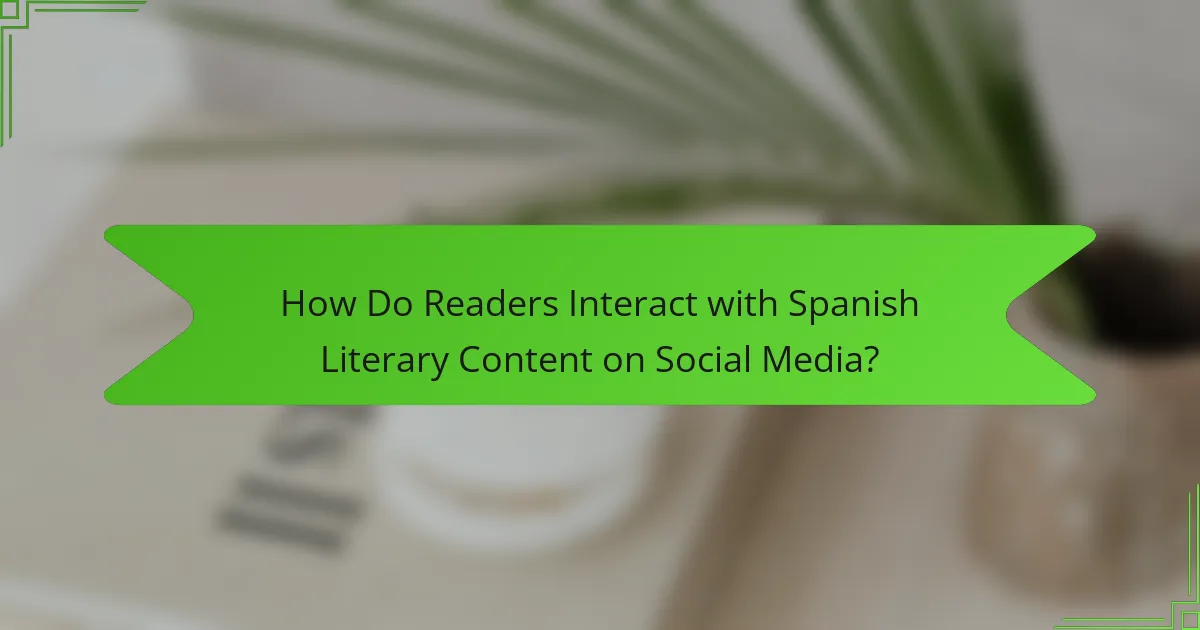
How Do Readers Interact with Spanish Literary Content on Social Media?
Readers engage with Spanish literary content on social media through sharing, commenting, and participating in discussions. These interactions enhance visibility and foster community among literary enthusiasts. For instance, hashtags related to Spanish literature often trend, allowing users to discover new works and authors. As a result, social media platforms serve as vital spaces for promoting Spanish literature and connecting readers.
What Types of Content Generate the Most Engagement?
Engagement in Spanish literature on social media is driven by visually appealing content, relatable themes, and interactive formats. Posts that incorporate quotes, vivid imagery, and discussions about cultural relevance tend to attract more interaction. Engaging with followers through polls and questions also enhances participation.
How Do Reader Preferences Vary Across Different Demographics?
Reader preferences in Spanish literature vary significantly across demographics, influenced by age, education, and cultural background. Younger audiences engage more with social media discussions, while older readers prefer traditional formats. Educational levels shape preferences for genre and depth of content. Additionally, cultural background impacts the themes and authors that resonate most with readers. For example, Latin American literature may attract more attention from Hispanic readers, while Spanish classics appeal to a broader audience.
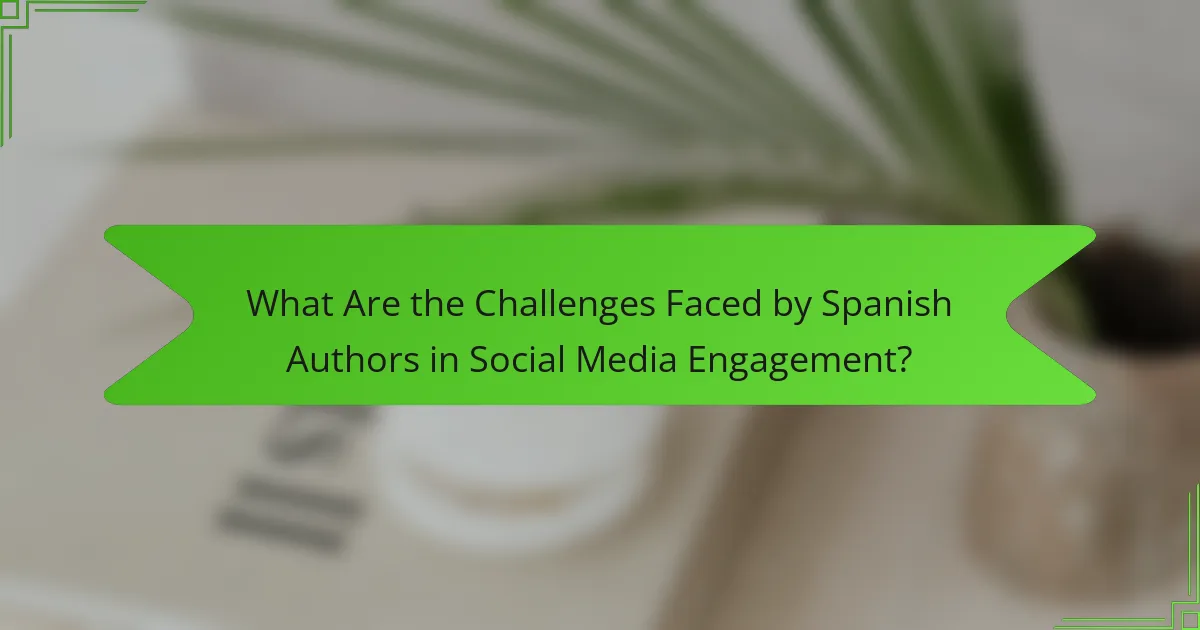
What Are the Challenges Faced by Spanish Authors in Social Media Engagement?
Spanish authors face several challenges in social media engagement, including limited visibility, language barriers, and audience fragmentation. These factors hinder their ability to connect with wider audiences and promote their work effectively.
Limited visibility arises from the vast amount of content on social media, making it difficult for Spanish authors to stand out. Language barriers can restrict their reach, particularly if they write in regional dialects or styles that are less understood outside their home countries. Audience fragmentation occurs as readers diversify their preferences across various platforms, complicating targeted engagement strategies.
Moreover, the fast-paced nature of social media demands constant content creation, which can be overwhelming for authors who are primarily focused on their literary work. Balancing creative writing with social media marketing often leads to a conflict between artistic integrity and commercial appeal.
As a result, Spanish authors must navigate these challenges while striving to maintain their unique literary voices in a crowded digital landscape.
How Do Authors Navigate Negative Feedback or Criticism?
Authors navigate negative feedback by leveraging social media to engage constructively with their audience. They often use criticism as a catalyst for growth, fostering dialogue and understanding.
Social media platforms enable authors to share their perspectives, clarify misunderstandings, and showcase resilience. This engagement can transform negative experiences into opportunities for deeper connections with readers.
For instance, Spanish authors like Javier Marías have effectively utilized Twitter to address critiques, offering insights that resonate with their followers. Such interactions can enhance an author’s visibility and reputation in the literary community.
In conclusion, by embracing feedback through social media, authors not only address criticism but also cultivate a supportive network that values open communication and mutual respect.
What Are Common Misconceptions About Spanish Literature in Digital Spaces?
Common misconceptions about Spanish literature in digital spaces include the belief that it lacks relevance and accessibility. Many assume that Spanish literature is only for academic audiences, ignoring its vibrant online communities. Additionally, some people think that digital platforms dilute the quality of literary discourse, while in reality, they enhance engagement and broaden reach. Misunderstandings also arise regarding the diversity of voices within Spanish literature, often overshadowed by a focus on canonical works.
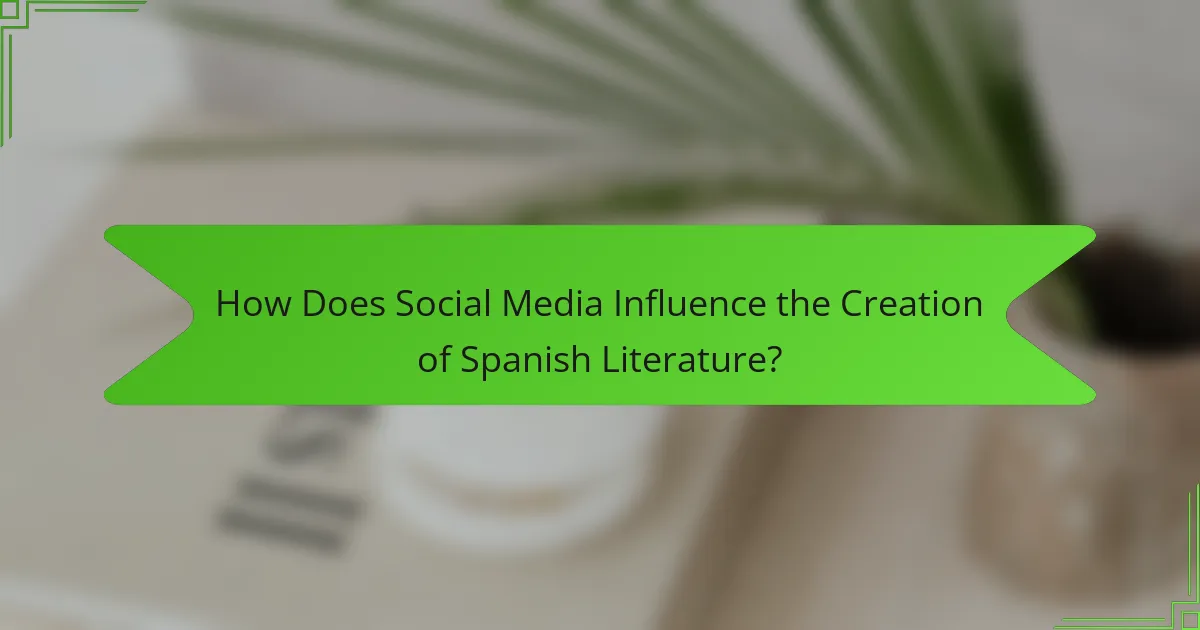
How Does Social Media Influence the Creation of Spanish Literature?
Social media significantly shapes Spanish literature by enhancing visibility and engagement among writers and readers. Platforms like Twitter and Instagram allow authors to share their work instantly and connect with audiences directly.
The interactive nature of social media fosters a community where feedback and discussions flourish. This engagement influences literary styles and themes, reflecting contemporary societal issues.
Moreover, social media acts as a publishing avenue, enabling emerging writers to bypass traditional gatekeepers. This democratization of literature encourages diverse voices and innovative narratives.
Finally, trends on social media can dictate popular genres and topics, impacting what literature resonates with readers. This interplay between social media and literature continues to evolve, shaping the future of Spanish literary culture.
What Are the Impacts of Reader Feedback on Literary Works?
Reader feedback significantly influences literary works by shaping authors’ narratives and enhancing audience engagement. Social media platforms facilitate direct communication, allowing readers to express opinions and critiques. This interaction fosters a dynamic relationship between authors and their audience, encouraging real-time adjustments to content. Moreover, Spanish literature benefits from this engagement, as authors can explore themes relevant to contemporary societal issues. The immediate nature of feedback can lead to unique attributes in literary works, such as localized cultural references or experimental writing styles. Ultimately, reader feedback enriches the literary landscape, making it more responsive and diverse.
How Are Collaborative Projects Between Authors and Readers Formed?
Collaborative projects between authors and readers are formed through social media interactions and shared interests. Authors engage with their audience via platforms like Twitter and Instagram, fostering dialogue that inspires collaborative writing efforts. These projects often include reader feedback, co-creation of content, and community-driven narratives, enhancing the relationship between creators and their audience. As a result, the intersection of Spanish literature and social media becomes a dynamic space for innovative storytelling and reader participation.

What Are the Unique Attributes of Spanish Literary Movements on Social Media?
Spanish literary movements uniquely engage on social media through dynamic interaction, diverse formats, and global accessibility.
These movements often utilize visual storytelling, such as infographics and videos, to attract younger audiences. Authors and literary critics leverage platforms like Twitter and Instagram to share insights, fostering real-time discussions.
Moreover, social media allows for the democratization of literature, enabling emerging voices to gain visibility alongside established authors. This shift creates a rich tapestry of content that reflects contemporary societal issues, enhancing the relevance of Spanish literature today.
The unique attribute of this engagement lies in the blend of traditional literary themes with modern digital culture, creating a vibrant community of readers and writers.
Which Literary Genres Gain More Attention Online?
Spanish literature, particularly works by contemporary authors, gains significant attention online due to social media platforms. These platforms facilitate direct engagement with readers, enhancing visibility for literary discussions and book promotions.
Genres such as magical realism and contemporary fiction resonate well, attracting diverse audiences. Social media campaigns, reader reviews, and influencer endorsements contribute to this heightened interest.
Moreover, the use of visual content, like book trailers and author interviews, amplifies engagement. Authors who actively participate in online discussions often see increased readership and community support.
The unique attribute of Spanish literature lies in its rich cultural narratives, which appeal to a global audience. As a result, this genre continues to thrive in the digital landscape.
How Do Regional Literary Events Leverage Social Media for Engagement?
Regional literary events leverage social media to enhance audience engagement through targeted campaigns and interactive content. These platforms facilitate real-time communication and foster community connections among literature enthusiasts.
Social media allows for live updates during events, creating a sense of urgency and excitement. Hashtags specific to the event encourage user-generated content, amplifying reach. For instance, events like the Feria Internacional del Libro in Guadalajara utilize Instagram and Twitter to showcase authors and sessions, attracting wider audiences.
Additionally, social media analytics provide insights into audience preferences, enabling organizers to tailor future events. This data-driven approach enhances the overall experience for attendees and participants alike.
Collaboration with influencers in the literary community further expands visibility, drawing in new demographics. By engaging with diverse audiences, regional literary events can cultivate a vibrant literary culture that thrives both online and offline.

What Best Practices Can Spanish Authors Adopt for Effective Social Media Engagement?
Spanish authors can enhance social media engagement by adopting best practices that resonate with their audience. They should prioritize authentic storytelling, interact consistently with followers, and utilize visual content to capture attention.
Engaging with readers through live sessions or Q&A fosters a sense of community. Authors can also collaborate with influencers or other writers to expand their reach. Monitoring analytics helps identify what content resonates best, allowing for data-driven adjustments.
Utilizing hashtags relevant to Spanish literature increases discoverability. Regularly sharing insights into their writing process can intrigue followers and build anticipation for upcoming works. Finally, embracing diverse formats, such as videos or podcasts, can diversify engagement strategies.
What Strategies Enhance Audience Interaction and Loyalty?
Engaging audiences through Spanish literature on social media enhances loyalty by fostering community and shared interests. Interactive content, such as polls and discussions, encourages participation. Highlighting relatable themes in literature can resonate with followers, creating emotional connections. Consistency in posting and responding to comments builds trust. Collaborating with influencers in the literary space can expand reach and deepen engagement.
Which Tools Are Most Effective for Managing Social Media Presence?
Effective tools for managing social media presence include Hootsuite, Buffer, and Sprout Social. These platforms streamline content scheduling, analytics, and engagement. Hootsuite offers robust analytics and team collaboration features. Buffer excels in user-friendly scheduling and performance insights. Sprout Social provides comprehensive reporting and customer relationship management. Each tool enhances engagement with audiences, particularly in the context of Spanish literature, by facilitating timely interactions and content sharing.
What Common Mistakes Should Authors Avoid in Their Online Strategies?
Authors should avoid common mistakes like neglecting audience engagement, failing to leverage social media analytics, and lacking a consistent posting schedule. These errors can hinder their visibility and connection with readers.
Engaging with followers is crucial; authors should respond to comments and messages to build a community. Ignoring feedback can lead to missed opportunities for growth and improvement.
Another mistake is underestimating the power of visuals. Posts with images or videos significantly increase engagement rates. Authors should incorporate multimedia elements to enhance their content.
Lastly, inconsistency in branding across platforms can confuse audiences. Authors must maintain a cohesive voice and style to strengthen their identity in the literary community.
